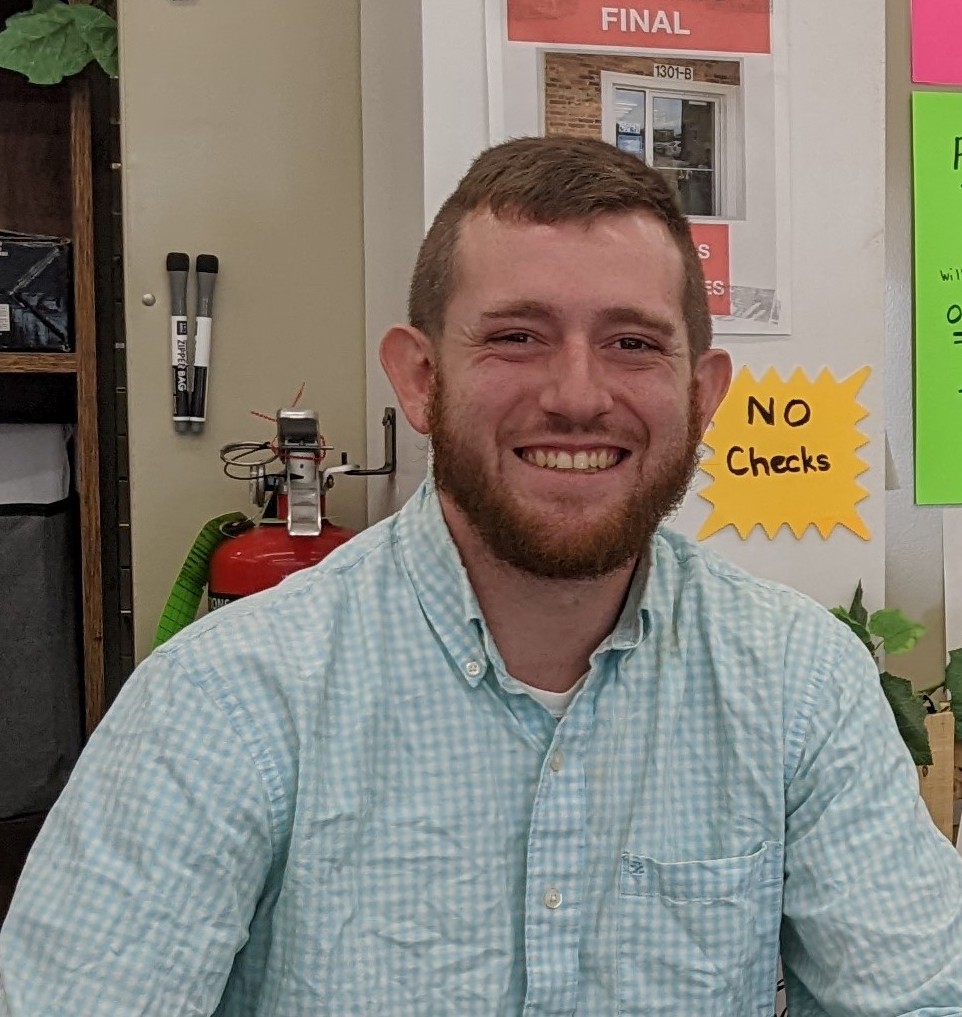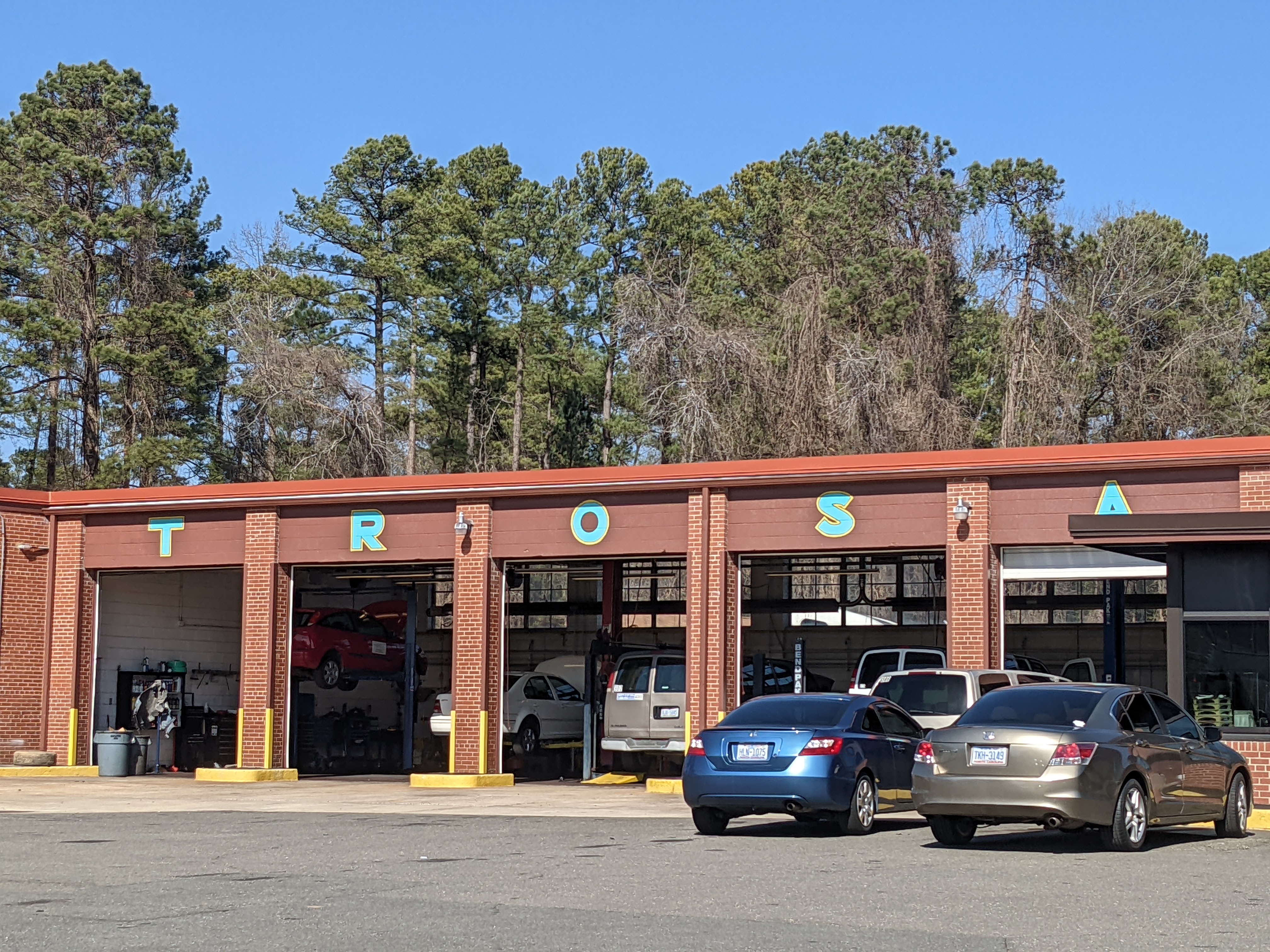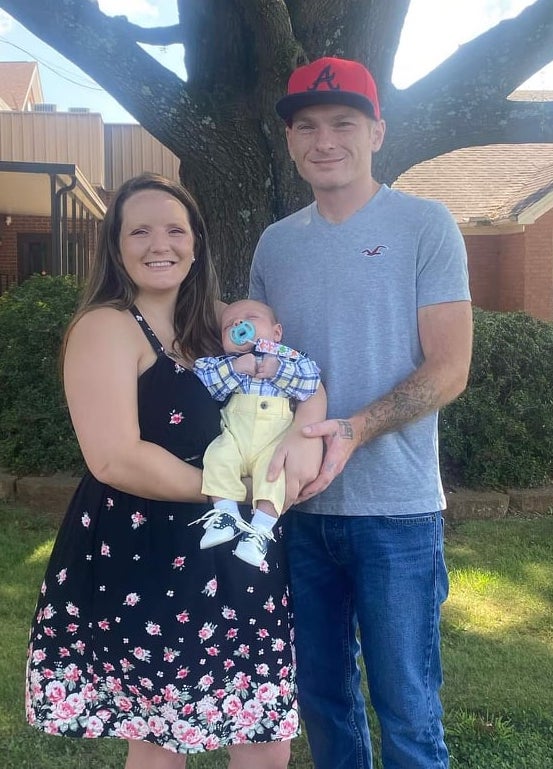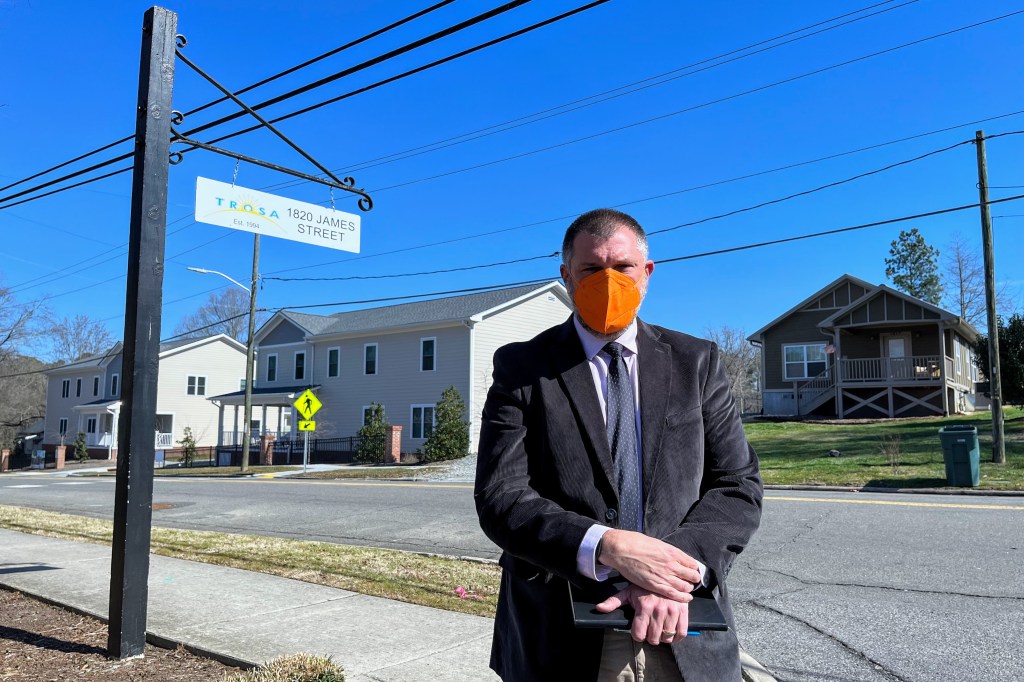DURHAM, N.C. — An addiction treatment facility, highly regarded by North Carolina lawmakers, sits in a residential neighborhood here and operates like a village in itself. Triangle Residential Options for Substance Abusers, better known as TROSA, hosts roughly 400 people a day on a campus with rows of housing units, cafeterias, a full gym, and a barbershop.
The program, which began in 1994, is uniquely designed: Treatment, housing, and meals are free to participants. And TROSA doesn’t bill insurance. Instead, residents work for about two years in TROSA’s many businesses, including a moving company, thrift store, and lawn care service. Program leaders say the work helps residents overcome addiction and train for future jobs. Of those who graduate, 96% of individuals remain sober and 91% are employed a year later, the program’s latest report claims.
Impressed with such statistics, state lawmakers recently allotted $11 million for TROSA to expand its model to Winston-Salem. It’s the largest amount in the state budget targeted to a single treatment provider and comes on the heels of $6 million North Carolina previously provided for its expansion, as well as $3.2 million TROSA has received in state and federal funds annually for several years.
This latest influx of taxpayer dollars — coming at a time when overdose deaths are surging and each dollar spent on treatment is crucial — is drawing criticism. Advocates, researchers, and some former employees and participants of TROSA say the program takes advantage of participants by making them work without pay and puts their lives at risk by restricting the use of certain medications for opioid use disorder. Although those who graduate may do well, only 25% of participants complete the program — a figure TROSA leaders confirmed.
“If I had known about this funding, I would have been the first person on the mic to [tell lawmakers], ‘I don’t think you all should do this,’” said K.C. Freeman, who interned at TROSA in 2018 and later spent two months on staff in the medical department. “You can’t look at the small number of people who had success and say this works. It’s not the majority.”
The dispute over TROSA’s funding comes amid national conversations about how to allocate billions of dollars available after landmark opioid settlements with drug companies. Two flashpoints in the North Carolina debate may provide a window into heated conversations to come. First: Are work-based rehabs legal or ethical? And second: Should every facility that receives public funding allow participants to use all medications for opioid use disorder?
Work as Treatment
Work-based rehabs are widespread across the country. The investigative news outlet Reveal identified at least 300 such facilities, including some that place participants in dangerous jobs at oil refineries or dairy farms with no training and exploit workers to bolster profits.
Many of these programs use a portion of their revenue to sustain the rehab and offer residents free housing or meals. That can make them attractive to state legislators, said Noah Zatz, a UCLA law professor who specializes in employment and labor law.
“Because essentially they’re running businesses off of people’s uncompensated labor, there is a built-in funding mechanism,” he said. “If the state doesn’t have to pay full freight to run a program … that might be a reason to like it.”
TROSA’s annual reports indicate more than half of its multimillion-dollar budget is funded through its businesses at which residents work, as well as goods and services that are donated to the program. About 30% of its funding comes from government grants and contracts.
Although TROSA and its leaders report no significant campaign donations, they spend upward of $75,000 a year on lobbying. In presentations, they often share a 2017 study — conducted by an independent research institute at TROSA’s request — which found TROSA saves the state nearly $7.5 million annually in criminal justice and emergency care costs.
The program’s self-financing aspect is part of its appeal for North Carolina Sen. Joyce Krawiec, a Republican who represents part of Forsyth County, where TROSA is building its new site.
“The good thing about TROSA: They raised most of their own funds,” she said in a phone interview.

It’s reasonable that residents don’t get paid for their work, she added, since they’re already receiving free treatment and housing. Other rehabs can be prohibitively expensive for many families, so TROSA provides a much-needed option.
But being a bargain doesn’t necessarily make it legal, Zatz and other labor experts said. A previous U.S. Supreme Court ruling suggests nonprofits that run businesses without paying employees could violate the Fair Labor Standards Act.
But TROSA administrators say they are not an employer; they are a therapeutic community. Clear policies guard against the exploitation of anyone, said Keith Artin, president and CEO. The jobs provide residents with structure and an opportunity to change their behaviors.
“The work-based element is essential to recovery,” Artin said. “We’re teaching people how to live.”
Toward the end of residents’ two-year stays, TROSA assists them in job-hunting and allows them to live on campus for several months while they work at a newfound job and build savings.
Diverging Work Experiences
TROSA’s model has widespread support among lawmakers and families affected by addiction. Benjamin Weston said it was “a blessing.”
Weston said he started using cocaine as a teenager and struggled with addiction for years. At 22, he entered TROSA. He said he was grateful for two years of free treatment.
After brief assignments in TROSA’s thrift store and moving company, Weston transitioned to the development office, where he solicited donations from local businesses. “It was meaningful work that also taught me a lot of good job skills,” he said.
Since graduating in 2016, Weston has worked in development for Hope Connection International, a nonprofit his mother started to support survivors of abuse and addiction.
Other graduates interviewed for this article talked about using the moving skills or commercial driving licenses they gained to obtain full-time jobs. Some said they’re buying houses and starting families — successes they credit to their experience in the program.
But not every resident finds the work model therapeutic. Several described working 10 to 16 hours a day, six days a week, in physically demanding moving or lawn care businesses. Several said there was little time for therapy and, with only a handful of counselors for hundreds of residents, wait times for a session could span weeks.
Freeman, the former TROSA employee who has a master’s in social work, said he thought residents rarely had an opportunity to process the trauma that made them use drugs in the first place. Although Freeman did not counsel clients — his role at TROSA focused on ordering and stocking medications — he said he noticed many graduates returned repeatedly to the program, struggling to stay away from substances once they left campus.
Richard Osborne first heard of TROSA while incarcerated on drug and theft-related charges. Like 38% of TROSA residents, he chose to attend the program as a condition of his probation.
One day in 2017, Osborne and other residents working with the moving company were unloading large boards of plywood from a trailer, when a board fell and smashed him against the trailer, he said. His vision became blurry and he worried about having a concussion, he said.
As he remembers it, no one suggested medical care. “The next day, they told me I had to get back to work,” he claimed.
That’s when Osborne said he decided to leave.

Today, Osborne, 31, said he has not used drugs in about four years, holds a steady job, and has a loving family. But it’s no thanks to TROSA, he said.
“They’re taking advantage of people at their low points in life,” he said. The moving company brings in $4 million a year, yet residents who work for it are not even allowed to keep tips, he added.
TROSA leaders confirmed the tips policy but said they could not comment on an individual residents’ experience. In general, CEO Artin wrote in an email, “when a resident is injured we ensure that they receive immediate medical attention and would never knowingly put a resident at risk.”
As a nonprofit, TROSA funnels revenue from its businesses back into the treatment program, he added.
The program’s 2020 tax documents show its top five employees combined earned over $750,000 in salary and benefits.
Medication Hesitancy
TROSA provides psychiatric care through a contract with Duke Health and offers group or individual counseling to residents who request it. The program employs four full-time counselors and partners with local providers who donate physical therapy, dental care, and other medical services.
But TROSA does not provide access to some of the most effective treatments for opioid use disorder: methadone and buprenorphine. Both medications activate opioid receptors in the brain and reduce opioid withdrawal and cravings. It’s been well documented that these medications greatly reduce the risk of opioid overdose death, and the FDA-approved drugs are considered the “gold standard” for treatment.
Right now, TROSA leaders say the only medication for opioid use disorder the program offers is naltrexone, an injectable medication that works differently than the other two because it requires patients to fully detox to be effective. Because of this, some experts are hesitant to use it, saying it puts people at higher risk of overdose death.
About one-third of TROSA participants report opioids are their primary drug of choice.
TROSA leaders said they’ve discussed adding the other addiction treatment medications but face logistical barriers. All medications at TROSA are self-administered, and leaders worry about diversion of oral methadone and buprenorphine, which are classified as controlled substances. They say they’d consider injectable buprenorphine, but it’s costly for their mostly uninsured participants.
“People choose to come here because it is a behavior modification program,” said Lisa Finlay, lead clinical counselor at TROSA. “They know that we don’t offer buprenorphine or those medications. We have people who have tried those medications in the past and believe that they actually led them back to using.”

Evidence suggests that people using medications for opioid use disorder have the best outcomes when they have access to other recovery support services, such as housing, employment, counseling, and a community. But while clinicians across the country have embraced these medications, leaders of residential treatment programs founded in the more traditional 12-step, abstinence-based recovery model have pushed back.
Some old-school recovery leaders claim the use of medications is simply replacing one drug with another, which has created stigma around this form of treatment.
A 2020 study found that about 40% of residential programs surveyed in the U.S. didn’t offer opioid use disorder medications and 20% actively discouraged people from using them. In North Carolina, there are 62 licensed long-term residential treatment facilities, according to the SAMHSA treatment locator, and fewer than half accept patients who take these medications. Only 12 facilities are licensed to prescribe buprenorphine.
This has resulted in tough conversations with patients for Kate Roberts, a clinical social worker on a UNC Health team that treats people with severe IV drug-related infections. Once patients are stabilized, many start buprenorphine, she said. Some say they want to go to a residential program for structure, job training, and to learn coping skills. Roberts recalled one patient saying to her: “I need to go to residential treatment and I need this medication because I fear I’ll die.”
“That’s really heartbreaking to hear a patient clearly articulate what it is that they need … which is in line with the [research] literature,” she said. “And that you know there are very few places in the state that offer that.”
Doctors and public health experts nationwide are pushing for lawmakers to fund rehab facilities that allow these medications, saying they’re the best way to combat the opioid crisis. Some medical and legal experts have said it’s in violation of the Americans with Disabilities Act to deny recovery services such as housing to people using medications for opioid use disorder. Health experts say that funding abstinence-based addiction programs could also inadvertently cause more overdoses if people leave the program and return to using drugs with a much lower tolerance, especially as fentanyl is rampant in the street drug supply.
These conversations will become only more important as opioid settlement funds arrive, said Bradley Stein, director of the national Rand Opioid Policy Center.
“The goal isn’t just to get people into treatment; it’s to get people doing better,” he said. “You want to make sure that you’re using the money effectively.”
The conversations have begun in North Carolina. When Rep. Graig Meyer (D-Durham) tweeted his support for TROSA late last year, clinicians reached out to him explaining their concerns about the program not allowing participants to use methadone or buprenorphine.
Although Meyer still believes it’s an effective program, he said, “I also have concerns from what I learned about TROSA’s approach to treating opioid addiction in particular. I’d like to see TROSA consider what their current practices are.”
This story was produced by KHN (Kaiser Health News), a national newsroom that produces in-depth journalism about health issues. Together with Policy Analysis and Polling, KHN is one of the three major operating programs at KFF (Kaiser Family Foundation). KFF is an endowed nonprofit organization providing information on health issues to the nation.



